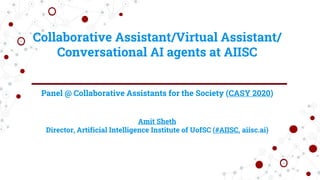Collaborative Assistant/Virtual Assistant/ Conversational AI agents at AIISC
- 1. Collaborative Assistant/Virtual Assistant/ Conversational AI agents at AIISC Panel @ Collaborative Assistants for the Society (CASY 2020) Amit Sheth Director, Artificial Intelligence Institute of UofSC (#AIISC, aiisc.ai)
- 2. ’üČ Focus on two domains: Health & Education ’üČ Broad variety: Simple chatbot (flexible interactions) to quite complex (manage chronic disease) ’üČ Uniqueness of complex examples: a. Context with deep domain knowledge, b. Personalization with personalized health knowledge graph, c. active/passive sensing, d. multimodal (text, voice, image) Examples ŌĆō at various stages of development ’āś Health-e Gamecock COVID-10 daily symptom checker ’āś Pediatric Asthma ’āś Nutrition ’āś Mental Health ’āś Autism, After Cancer Exercise, Diabetes, and more in planning. http://wiki.aiisc.ai/index.php/Covid19
- 3. 1. Self Monitoring 2. Self Appraisal 3. Self Management 4. Intervention 5. Disease Progression and Tracking Virtual Health Assistant for Augmented Personalized Health: example of Asthma ŌĆó Complex- multifactorial disease, personalized ŌĆó Access- challenges in working with patients (IRB, privacy, medical/clinical knowledge and lack of gold standards, etc.
- 4. 4 Sensor, Social, Clinical Datastreams: Informed & Intelligent Questions Weather information (temperature, pollen, humidity, etc) Elasticsearch (ES) Database Query & Rule Abstract raw values into information Asthma Domain Knowledge https://bioportal.bioontology.org/ontologies/AO http://www.childhealthservicemodels.eu Patient Data from EMR & PGHD (Compliance score, prescribed medications, asthma control level) IoTs (Foobot & Fitbit) Conversation Rules & Scripts (DialogFlow) Sensor,Social,Clinical Architectural Framework for Intelligent & Informed Conversations: kBOT Asthma Sensor (IoTs) & Cyber Datastream Clinical (Baseline) Datastream Patient Consented Social Data (Facebook, Instagram, Twitter Activity) Social Datastream Knowledge Datastream Ōśģ Smarter & engaging agent Ōśģ Minimize active sensing (Questions to be asked) Ōśģ Ask only informed & intelligent questions Ōśģ Relevant & Contextualized conversations Ōśģ Personalized & Human-Like Human-Like Aspect
- 5. Contextualization and Personalization kBOT initiates greeting conversation. Understands the patientŌĆÖs health condition (allergic reaction to high ragweed pollen level) via the personalized patientŌĆÖs knowledge graph generated from EMR, PGHD, and prior interactions with the kBOT. Generates predictions or recommended course of actions. Inference based on patientŌĆÖs historical records and background health knowledge graph containing contextualized (domain-specific) knowledge. Figure: Example kBOT conversation which utilizes background health knowledge graph and patientŌĆÖs knowledge graph to infer and generate recommendation to patients. Ōśģ Conversing only information relevant to the patient 5
- 6. ŌĆ£Huge need in several fields ŌĆō health and education among the important areas. ŌĆó Examples from health domain: not enough available clinical expertise to meet mental health needs; chronic disease need continuous care; massive growth in patient generate data with demonstrated value for making decisions on health, wellness and fitness. But, Quite challenging: big data challenges ŌĆō esp variety of data, need for context to interpret data (and relevant deep domain knowledge), personalization for each patient, need to be able to explain results before clinicians will take the technology seriously, ease of use/UX, incentives in validation studies (patients, clinicians, insurance companies), etc.
Editor's Notes
- Architecture slide, sensor, social, clinical






